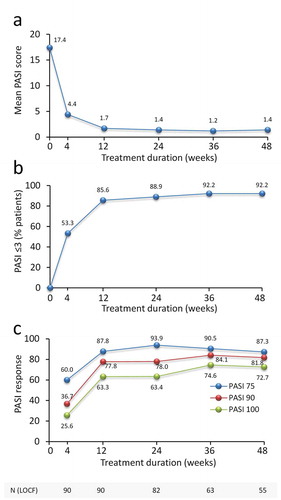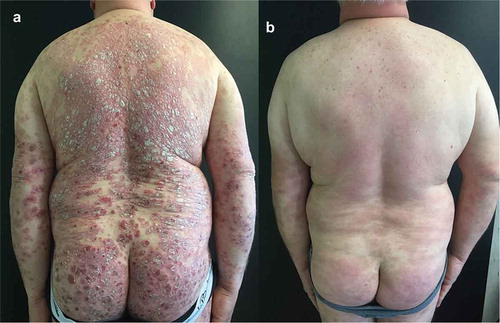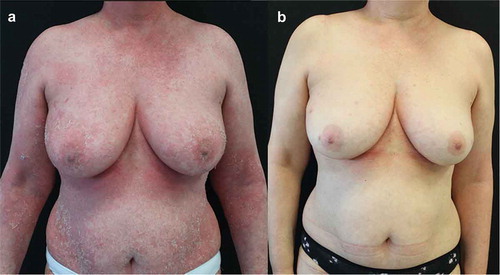Figures & data
Table 1. Baseline clinical characteristics of psoriasis patients
Table 2. Reason for switching from an anti-IL17A to brodalumab
Table 3. Reason for switching from an anti-IL17A to brodalumab and outcome
Figure 1. Effect of brodalumab in psoriatic patients on PASI score and achievement of PASI 75, 90 and 100 response over 48 weeks. (a) PASI is presented as mean values. (b) % patients achieving a PASI score ≤3 and (c) % patients achieving PASI 75, 90 and 100 response. Mean PASI score, % patients achieving PASI score ≤3 and % patients achieving PASI 75, 90 and 100 response are presented for each time point. The number of patients at each time point is shown. LOCF = last observation carried forward (LOCF) method

Figure 2. Representative images of outcome at the back and gluteal region in Patient #1. A male patient, aged 50 years with onset of psoriasis at 38 years of age and BMI of 25.1 At baseline, PASI was 48 (A). After 4 and 24 weeks with brodalumab, PASI decreased to 15 and 8 respectively (B)

Figure 3. Representative images of outcome in the breast/abdomen region in Patient #2. A female patient aged 56 years with onset of psoriasis at 50 years of age treated for erythrodermic psoriasis. After presenting with diffuse erythroderma (A), that was treated with systemic steroids and brodalumab at scheduled dosage, she experienced a rapid improvement, reaching clinical remission in 3 months (B)

Figure 4. Representative images of outcome at the lower back and gluteal region in Patient #4. A female patient aged 41 years treated for chronic plaque psoriasis. After presenting with severe chronic plaque psoriasis that was treated with UVB phototherapy, methotrexate and a range of other biologics, she complained of generalized eczema with diffuse intense itching symptoms during treatment with ixekizumab (A). Subsequent failure of treatment with guselkumab resulted in fine scaling and diffuse psoriatic lesions, mainly localized on the back and legs (B) that was subsequently treated with brodalumab at scheduled dosage where she experienced a rapid improvement, achieving clinical remission in 4 months (C)

Figure 5. Representative images of outcome at the back and gluteal region in Patient #5. A male patient aged 68 years with arterial hypertension and type-2 diabetes mellitus and onset of episodes of erythrodermic psoriasis during his life. At baseline, PASI was 15 (A). After 2 weeks of brodalumab treatment, PASI decreased to 0.5 (B). Brodalumab was suspended for 3 months as the patient was admitted to the Stroke Unit of another hospital with a diagnosis of cerebral infarction and an endarterectomy of the right carotid. Brodalumab was started again and after two weeks PASI score decreased from 52 to 3 (D)

Figure 6. Representative images of outcome at the abdomen and chest region in Patient #6. A male patient aged 39 years with severe chronic plaque psoriasis. At baseline, PASI was 42 (A). After a few weeks with brodalumab, complete remission was achieved (B). After 56 weeks, treatment was suspended due to personal difficulties and excessive alcohol consumption and after 1 month the patient was erythrodermic (PASI 59) and with a compromised quality of life (C). He was engaged to change his lifestyle and also restarted brodalumab with a new cycle (without induction phase) and after 8 weeks PASI 75 was achieved with complete remission obtained after 16 weeks

